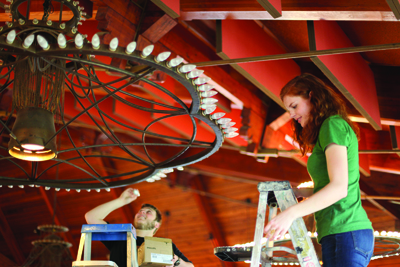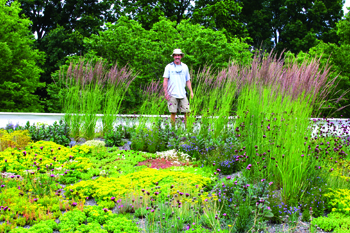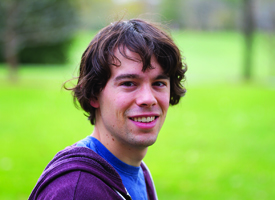So Green are Our Students

Students install low-energy light bulbs in campus light fixtures. Photo by Camille Roberson ’13
Look around the Swarthmore campus, and everywhere you’ll see evidence of student-initiated green activity. From the College’s oldest green student group Earthlust—founded in the 1990s and responsible in part for the College’s purchase of renewable energy—to the recent Parrish Beach organic lawn project, students have had their hands on the steering wheel in matters of sustainability, both on and off campus.
The Green Advisers (GA), an offshoot of Earthlust, lobby for green living on dorm halls, motivating their neighbors to compost waste regularly, recycle papers, use low-energy light bulbs, and read the weekly GA Digests posted in bathroom stalls with bits of advice on living green.
The Good Food Project organization manages, among other things, a community organic garden on Yale Avenue, a hydroponic lettuce farm suspended in the windows of Eldridge Commons, and a campus-composting program.
Historically, students have also weighed in on decisions concerning green building practices, and they have a presence in important groups such as the Sustainability and the Crum Woods Stewardship committees.
Students are also involved in off-campus activism.

Planting green roofs is another priority of groups concerned with on-campus greening. Photo by Diane Mattis
Swat Frack Action members raise awareness of hydraulic fracturing—the controversial method of obtaining natural gas from shale—in favor of cleaner, safer energy technologies. Group co-founder Dinah DeWald ’13 reports that 700 student signatures contributed to a public petition that resulted in the postponement of fracking in the Delaware River Basin.
Students for Mountain Justice protest mountaintop removal coal mining in Appalachia and campaign to shift College investments away from coal, natural gas, and oil companies, with the goal of reinvesting that money in companies that do business in a socially responsible way, according to member Sachie Hopkins-Hayakawa ’13.
Think Climate members initiate on- and off-campus discussions about climate change by hosting a weekly radio talk show and participating in community events.
Swarthmore Environmental Justice members join with off-campus organizations to address injustice in local communities. Students initiated The Chester Garden Project, working with Chester residents to grow, harvest, and distribute fresh vegetables and fruits to community members. Currently, they are forming a youth cooperative that empowers local teenagers to create and run a produce-distribution service.
A couple of years ago, in an effort to provide cohesion and cooperation among the many groups, then–Lang Center Environmental Sustainability Intern Camille Robertson ’13 created the EcoSphere Coalition, which brings together representatives from all groups once a month to share information on their activities. A listserv enables members to keep in touch.
According to Patrick Ammerman ’14, Robertson’s successor as Lang Center intern, “Based on an aggregate of the mailing lists of the seven student groups and others who have asked to join, 523 students and community members actively participate in sustainability on campus.”

Patrick Ammerman ’14 (above), this year’s sustainability intern, sponsored by the Lang Center for Civic and Social Responsibility, is coordinator of all the sustainability groups—tracking their activities, planning meetings, and keeping them in touch. Photo by Laurence Kesterson
During her tenure, Robertson also lobbied faculty, staff members, and students to write letters stating why the College needs a sustainability coordinator. As a result, Clara Fang was hired in summer 2011 for a 10-month position. “I’d love to see that position created for the long term,” Robertson says.
Ammerman agrees: “Already a successful addition to many campuses, a sustainability director would provide coordination and full-time dedication to campus sustainability.”
Students are also pressing for an environmental studies (ES) major. Last August, Ben Goloff and Julia Carleton, now sophomores, submitted to the College administration a 17-page paper titled “The Future of Environmental Studies at Swarthmore: A Proposal for Revising and Expanding Interdisciplinary Environmental Studies at Swarthmore College.”
Goloff’s and Carleton’s fastidiously researched and eloquently expressed compilation included a detailed description of an Environmental Studies Department with core faculty members and in which ES would be a second major alongside an external disciplinary major. They outlined requirements for staffing, space, funding, curriculum, and a timeline for the new department. They also contrasted Swarthmore’s ES offerings with those of 24 similar institutions, showing the College to be lagging in several areas.
“The Environmental Studies Committee discussed the proposal, and the reception was overwhelmingly positive,” says Peter Collings, Morris L. Clothier Professor of Physics. “In past discussions of a possible environmental studies major, concerns were raised that such a major could result in a lack of depth in any field. The proposal that an environmental studies major be a second major not only solves this problem but allows for coordination between the two majors.”
 Email This Page
Email This Page